
Tuesday, 9 December 2008
Another venus
Another go at venus. Well it was sitting there in the almost daylight allowing much easier telescope setup, so I thought I'd have a quick go. By the time it was all set and focused, it was pretty dark, and I got a few shots before is sank below next doors roof. This is probably the best of them.


Thursday, 4 December 2008
Venus and Jupiter
I missed the transition of the moon and Venus recently - clouds and, well I forgot/had to ferry the children around at the time I could have seen it. Anyway, last night I did see Venus and Jupiter although they had moved away from the moon. However this called for some quick photography as they started to set behind the opposite house roof and getting set up in time always takes longer when you are in a hurry - plugs just won't fit into holes, especially in the dark. So I expect the focusing isn't as good as it could be.

Shows up the street light glow rather well dontcha think?

Shows up the street light glow rather well dontcha think?
Wednesday, 19 November 2008
A bit of a mix
Going home last night I spotted Jupiter on the horizon from the bypass. Not that unusual its been there for a while, but wait, there is a companion with it today - Venus.
I rushed home and got out the camera, but the position was not very good - both were sinking fast and there was a number of things in the way. In the end the only way I could get them both in the frame was to straddle a tree!

As the sky was very clear, I had a go at a couple of other items too - the pleiades again.

I also tried M42 but haven't finished processing that one yet.
I rushed home and got out the camera, but the position was not very good - both were sinking fast and there was a number of things in the way. In the end the only way I could get them both in the frame was to straddle a tree!

As the sky was very clear, I had a go at a couple of other items too - the pleiades again.

I also tried M42 but haven't finished processing that one yet.
Tuesday, 21 October 2008
Deep sky
After buying some more stuff (mostly batteries and USB leads - so relatively cheap) I had another go at some deep sky stuff. I've never really seen the andromeda galaxy, but tonight I did see it, and photographed it too! However the photographs will need some work I think, but here are some preliminary pictures.
 This one shows it rather overenhanced, but you can also see the small galaxy just above it.
This one shows it rather overenhanced, but you can also see the small galaxy just above it.

 This one shows it rather overenhanced, but you can also see the small galaxy just above it.
This one shows it rather overenhanced, but you can also see the small galaxy just above it.
Friday, 19 September 2008
Jupiter again
Jupiter is starting to get higher in the sky, but the conditions have been dreadful for a long time now. When it hasn't been raining its been threatening rain. All this adds up to lots of cloud cover.
Anyway, last night - just for a while, some of the sky was visible. There was still scattered cloud around, but less than normal and I could see Jupiter shining out - still not that much above the horizon.
I could also see that a couple of houses away, they had some sort of light show going on in their garden, as their tree's were backlit - hmmm!
Anyway - I had a go, the telescope aligned and settled on Jupiter very nicely. With the LPI I took some images and got some reasonable results.
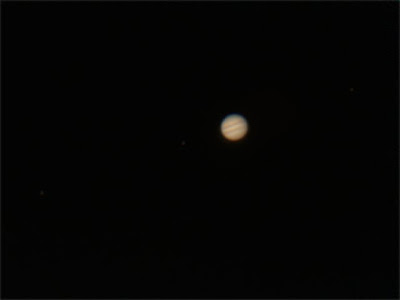
With a bit of enhancement you can see some of the satellites too.
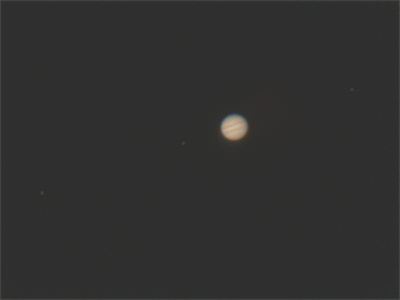
From left to right, Ganymede, Io and Europa on the right.
Then I got it to find Andromeda, nope - nothing, far too hazy and messy in that direction.
Anyway, last night - just for a while, some of the sky was visible. There was still scattered cloud around, but less than normal and I could see Jupiter shining out - still not that much above the horizon.
I could also see that a couple of houses away, they had some sort of light show going on in their garden, as their tree's were backlit - hmmm!
Anyway - I had a go, the telescope aligned and settled on Jupiter very nicely. With the LPI I took some images and got some reasonable results.

With a bit of enhancement you can see some of the satellites too.

From left to right, Ganymede, Io and Europa on the right.
Then I got it to find Andromeda, nope - nothing, far too hazy and messy in that direction.
Wednesday, 30 July 2008
Jupiter in the round
A quick look outside and its a clear night. I can't be bothered to set up the telescope, but I take a look through binoculars at Jupiter, which is looking quite clear. As I watch, I see the ISS go overhead!
Anyway, I decide its worth a photograph, so I get out the camera and tripod and take a few snaps at various settings to see what I can get. Its nothing like what you see in the telescope, but it makes for a nice assemblage.
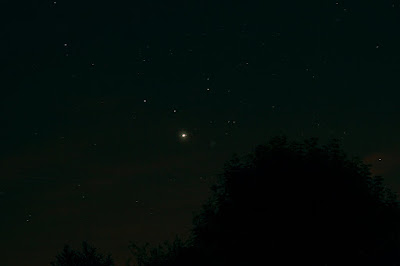
If you zoom in, you can see the motion blur dragging the points out into streaks, and this is only a 10s exposure, but from a distance it looks pretty ok. Zoom in not quite so far and you can see some of the satellites.
Anyway, I decide its worth a photograph, so I get out the camera and tripod and take a few snaps at various settings to see what I can get. Its nothing like what you see in the telescope, but it makes for a nice assemblage.
If you zoom in, you can see the motion blur dragging the points out into streaks, and this is only a 10s exposure, but from a distance it looks pretty ok. Zoom in not quite so far and you can see some of the satellites.
Wednesday, 23 July 2008
Jupiter - another go
I had another shot at Jupiter last night. With the telescope on the patio, I have a window of about 15-20 minutes when it is visible between two trees. This time I got set up a little earlier and managed two separate imaging samples. The visibility wasn't that great with it low on the horizon, and again it didn't look as good through the LPI webcam as through the lens. I guess the old mark one eyeball still has a useful range and pixel density.
You can see three of the satellites however, so that's a little better.

Also this time I had the settings right so I could post process the images with registax, which I think does a better job than envisage.
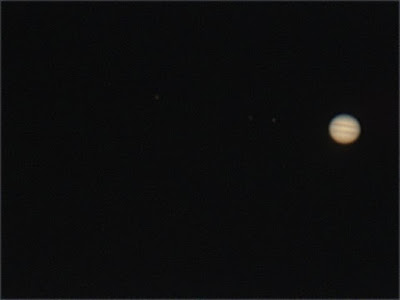
I might try a different technique if I get a chance.
You can see three of the satellites however, so that's a little better.

Also this time I had the settings right so I could post process the images with registax, which I think does a better job than envisage.

I might try a different technique if I get a chance.
Monday, 21 July 2008
Jupiter
Its been a while - but now the nights are getting a little earlier and I can be bothered to stay up. Also there is a new jewel in the sky, in the shape of Jupiter, so its time to have a go and see what can be got.
Its not easy, Jupiter is low in the sky between some trees, and after a few goes, the only place I can get a good view of it is from in the middle of a wooden bridge. This is not ideal, as everytime I move, the image leaps around. Even so, its the first go and the images are okish, but would be better if I'd saved them in a better format.
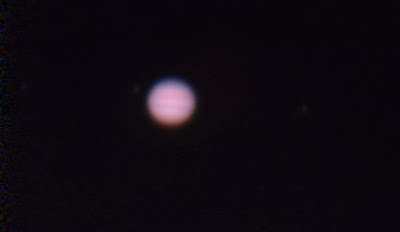
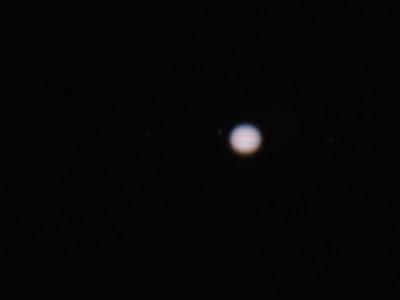
Maybe another night I'll have a better go, and remember a few more things. You can see a couple of moons, but its not as clear as it is through the eyepiece.
Its not easy, Jupiter is low in the sky between some trees, and after a few goes, the only place I can get a good view of it is from in the middle of a wooden bridge. This is not ideal, as everytime I move, the image leaps around. Even so, its the first go and the images are okish, but would be better if I'd saved them in a better format.


Maybe another night I'll have a better go, and remember a few more things. You can see a couple of moons, but its not as clear as it is through the eyepiece.
Tuesday, 6 May 2008
The moon and mercury
Its been a while since I took any photos of the night sky. What with some foul weather, and a dose of flu that had me confined to bed for a week, the opportunities have been thin on the ground. However tonight it was clearish, although some hazy cloud around, and I wondered about looking for some M object or other to try and photograph. However checking with a few star charts, and with stellarium, it seems Mercury might be visible soon after sunset.
Its in the west obviously, which is not a good view from our garden. A whacking big house being in the way for one! However we have a balcony on the front of the house that we never use, which I thought might be useful. It turns out to be an excellent platform for this. Being on the first floor, its not too far being at roof top level, or at least looking over the houses across the street is only 1 or 2 degrees from horizontal.
Anyway, I scanned the sky anxiously as the Sun set. Stellarium showed the moon would be lined up with Mercury, but such a thin wedge that it might not be visible. Eventually after much scanning, and not a little ridicule from the neighbours, I spotted a thin rim of the moon.
About 30 minutes later, as it got darker, there was Mercury - right where it should be!
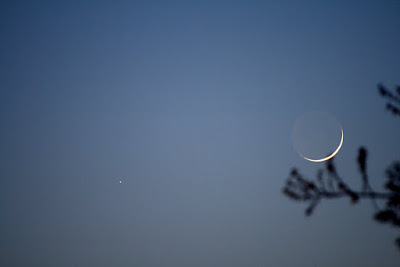
Its in the west obviously, which is not a good view from our garden. A whacking big house being in the way for one! However we have a balcony on the front of the house that we never use, which I thought might be useful. It turns out to be an excellent platform for this. Being on the first floor, its not too far being at roof top level, or at least looking over the houses across the street is only 1 or 2 degrees from horizontal.
Anyway, I scanned the sky anxiously as the Sun set. Stellarium showed the moon would be lined up with Mercury, but such a thin wedge that it might not be visible. Eventually after much scanning, and not a little ridicule from the neighbours, I spotted a thin rim of the moon.
About 30 minutes later, as it got darker, there was Mercury - right where it should be!

Thursday, 10 April 2008
Saturn again
Last night, I spent a long time trying images of Saturn. I've got a new motorised focuser, which finally means I can focus in an out with out any perceptible shake of the image. This makes it a little easier getting an image into focuser, although its still a lot of trial and error.
This is the best of the pictures from last night.
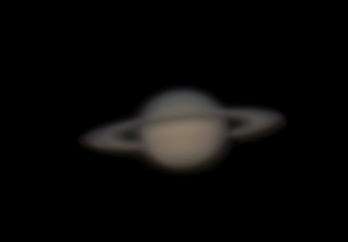
This is the best of the pictures from last night.

Tuesday, 8 April 2008
An iridium flare
Last night was a great night for observing orbital things, in theory. The space shuttle, a number of rocket bits and pieces and various other satellites were all scheduled to pass overhead.
However, that was the theory. In practice there was an awful lot of cloud about. None of that wispy mostly transparent stuff. No, this was thick piled up stuff as dense as you like. But - it wasn't wall to wall, at least not all the time.
Anyway - I went out to try and spot the ISS - although it was a bright pass, the time was not good, as the sky was still a faint bluey colour, the sun not having set very long ago. I could see a couple of the brighter stars after a while and the ISS should be magnitude -1.8 which is brighter than pretty much anything else in the sky other than the moon, but it wasn't looking good for the 3rd magnitude rocket bit that was coming over at the same time. I managed to spot the ISS eventually, but it wasn't the bright object it normally was.
I skipped most of the other passes as they were not very bright and with the large covering of cloud, would be difficult to spot. However there was an iridium flare scheduled for about 5 minutes to 10. The iridium satellites are a whole group of orbiting communication satellites, that have a highly polished panel attached, that if it happens to be in just the right orientation reflects the sun very brightly. There are programs to predict these events, I used the heavens above site.
I set up my point-and-shoot digital camera on video mode on a tripod pointing roughly in the right direction to try and spot it. I waited until about the right time, and then pressed the button and hoped that it was pointing about right, and that nasty bank of cloud would not obscure it.
What do you know, I saw it and caught it too!
It looks better at the original resolution, but you can see a bright dot at least. It is magnitude -7 or so, which is very bright indeed.
However, that was the theory. In practice there was an awful lot of cloud about. None of that wispy mostly transparent stuff. No, this was thick piled up stuff as dense as you like. But - it wasn't wall to wall, at least not all the time.
Anyway - I went out to try and spot the ISS - although it was a bright pass, the time was not good, as the sky was still a faint bluey colour, the sun not having set very long ago. I could see a couple of the brighter stars after a while and the ISS should be magnitude -1.8 which is brighter than pretty much anything else in the sky other than the moon, but it wasn't looking good for the 3rd magnitude rocket bit that was coming over at the same time. I managed to spot the ISS eventually, but it wasn't the bright object it normally was.
I skipped most of the other passes as they were not very bright and with the large covering of cloud, would be difficult to spot. However there was an iridium flare scheduled for about 5 minutes to 10. The iridium satellites are a whole group of orbiting communication satellites, that have a highly polished panel attached, that if it happens to be in just the right orientation reflects the sun very brightly. There are programs to predict these events, I used the heavens above site.
I set up my point-and-shoot digital camera on video mode on a tripod pointing roughly in the right direction to try and spot it. I waited until about the right time, and then pressed the button and hoped that it was pointing about right, and that nasty bank of cloud would not obscure it.
What do you know, I saw it and caught it too!
It looks better at the original resolution, but you can see a bright dot at least. It is magnitude -7 or so, which is very bright indeed.
Tuesday, 1 April 2008
ISS and ATV
The ISS is being serviced by the ATV at the moment. They are in about the same orbit, but the ATV is just a little ahead of the ISS. The ISS is very visible at magnitude -2 or better, and the ATV is noticeable as it is leading the ISS. This particular ATV is the Jules Verne and is testing out various things.
Anyway, it was clear last night, but there was high level cloud which made everything a bit fuzzy, and the photos didn't show very much.
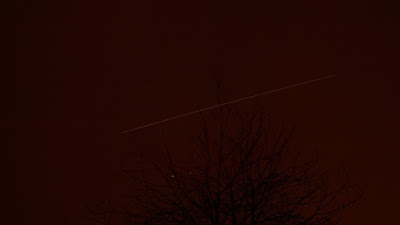
Tonight it was a much crisper night, and I tried taking the camera off manual and letting it take different length exposures based on the available light. They varied from about 5 seconds to 10 or 12. One of them actually caught both vehicles and showed them up quite nicely after a bit of rebalancing of levels. You can see the ISS as the main streak, and just to the top of the frame there is a thin streak from the ATV.
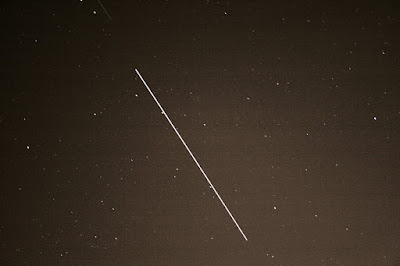
Also evident was about 3/4 of the way across the sky it went into shadow and started to fade, which is caught in the last one.

Anyway, it was clear last night, but there was high level cloud which made everything a bit fuzzy, and the photos didn't show very much.

Tonight it was a much crisper night, and I tried taking the camera off manual and letting it take different length exposures based on the available light. They varied from about 5 seconds to 10 or 12. One of them actually caught both vehicles and showed them up quite nicely after a bit of rebalancing of levels. You can see the ISS as the main streak, and just to the top of the frame there is a thin streak from the ATV.

Also evident was about 3/4 of the way across the sky it went into shadow and started to fade, which is caught in the last one.

Tuesday, 25 March 2008
Another go at Saturn
I thought it was time to switch back from the DSLR to the LPI CCD camera and have another go at planetary imaging. After tea I had a look outside, and had noted the relatively clear skies throughout the day so thought it worth a go.
Having got the equipment outside, and selected polar alignment, I watched as polaris, and actually nearly the whole sky began to cloud over. By the time I was ready to try aligning there were no stars left to align on! So I went in and watched some TV and had a cup of coffee. An episode of Torchwood later, and the sky had cleared nicely.
I hooked up the LPI and the laptop, and tried Mars to begin with. A couple of attempts but it wasn't really showing up as more than a slightly orange blob.
So I switched to Saturn, which is now much higher in the sky. After a bit of fiddling around, and attempting to use the LPI to both image and guide, and a couple of software lockups, I succeeded in getting something.
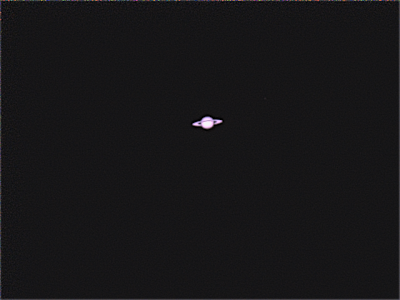
Not too bad, in fact it was looking good enough that I thought it would withstand a bit more magnification. So I went inside and got a 2x barlow lens and slotted it in.
It was definitely larger, but focusing was really difficult.

After a bit more fiddling around, and using registax on the results and a bit of tweaking this is sort of the final version, even showing a moon.
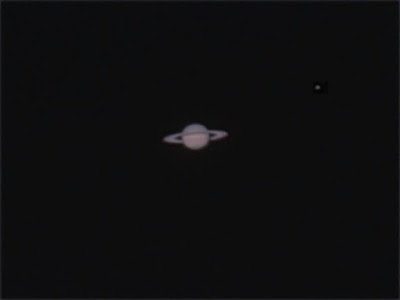
This has to be the best Saturn image I have to date, which is nice!
Having got the equipment outside, and selected polar alignment, I watched as polaris, and actually nearly the whole sky began to cloud over. By the time I was ready to try aligning there were no stars left to align on! So I went in and watched some TV and had a cup of coffee. An episode of Torchwood later, and the sky had cleared nicely.
I hooked up the LPI and the laptop, and tried Mars to begin with. A couple of attempts but it wasn't really showing up as more than a slightly orange blob.
So I switched to Saturn, which is now much higher in the sky. After a bit of fiddling around, and attempting to use the LPI to both image and guide, and a couple of software lockups, I succeeded in getting something.

Not too bad, in fact it was looking good enough that I thought it would withstand a bit more magnification. So I went inside and got a 2x barlow lens and slotted it in.
It was definitely larger, but focusing was really difficult.

After a bit more fiddling around, and using registax on the results and a bit of tweaking this is sort of the final version, even showing a moon.

This has to be the best Saturn image I have to date, which is nice!
Thursday, 13 March 2008
Constellations
It was very windy last night, so I didn't try any telescope shots. There was a lot of broken cloud about and it kept obscuring different parts of the sky. However with the camera on a tripod hooked up to the laptop I thought it worth a few shots. With it fully wired up, once you are focused and aligned you can just leave it to get on with 25 shots of 25 seconds and go into the warm.
I started with the plough, as it is nicely aligned and easy to see. Had a go at Saturn in Leo, but clouds and aircraft conspired to wreck that.
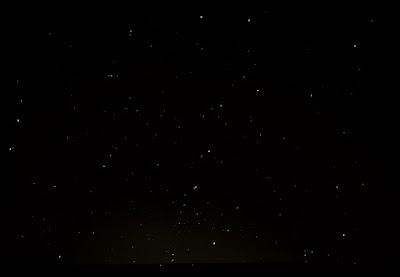
Cassiopeia looked reasonable so I took quite a few of that and stacked them. I need to get better at post processing though.

I started with the plough, as it is nicely aligned and easy to see. Had a go at Saturn in Leo, but clouds and aircraft conspired to wreck that.

Cassiopeia looked reasonable so I took quite a few of that and stacked them. I need to get better at post processing though.

Wednesday, 5 March 2008
Another go at the orion nebula
I tried some rather short exposure settings on M42, but decided this time to try some 25s exposures with the DSLR mounted at prime focus on the telescope. I wasn't sure that the telescope would track well enough. Also Orion is just above the house and descends below it through the night, so not an ideal location either. Anyway - worth a try.
It turned out that many of the images had elliptical stars, or were smeared out, but there were a number within the 25 taken that looked ok.
I used DSLRshutter program to take them which worked pretty well. I also experimented with nebulosity for focussing without much success.
Anyway - after throwing lights, flats, darks and biases at deep sky stacker, it pronounced that only one of the images was worth stacking... its probably right but it could have broken the news gently!
Anyway, its probably my best shot of M42 to date, but still not much compared with anyone who's any good!
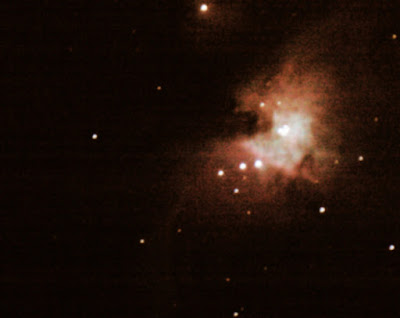
Step by step, its getting a bit better.
It turned out that many of the images had elliptical stars, or were smeared out, but there were a number within the 25 taken that looked ok.
I used DSLRshutter program to take them which worked pretty well. I also experimented with nebulosity for focussing without much success.
Anyway - after throwing lights, flats, darks and biases at deep sky stacker, it pronounced that only one of the images was worth stacking... its probably right but it could have broken the news gently!
Anyway, its probably my best shot of M42 to date, but still not much compared with anyone who's any good!

Step by step, its getting a bit better.
Tuesday, 26 February 2008
More equipment
I got a zoom lens for the DSLR, and tried a few shots of th night sky with that. The results were not bad. These were taken from a tripod rather than a telescope mount so you can't do long exposures of the stars start to streak. Setting high ISO numbers and short exposures is the compromise.
Here is the Orion nebula taken.
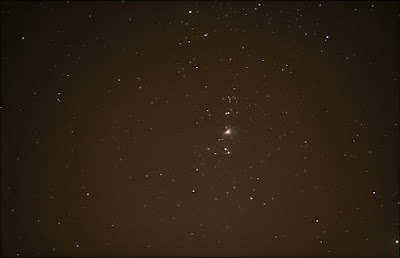
and here is the Pleiades taken similarly.
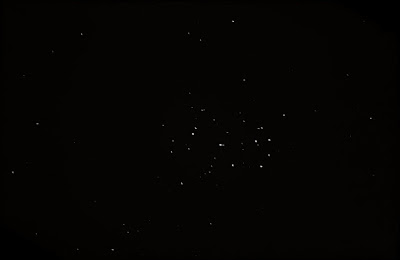
and one with the shorter lens of the plough again

Then a couple of days later I tried the camera connected to the telescope again. I had it equatorially mounted and it seemed a little smoother. A number of the photos came out streaky though, so it was a question of picking the best to stack. So here is the orion nebula (M42) again looking a little better.

Its starting to look better. I'm not sure about the focusing though, and I'm not sure they are as straight as they could be. However the success story has to be the remote release I bought that connects to the laptop and the Delphinius software that allows you to setup a shooting schedule and go inside for a coffee while it takes and downloads 20 shots or more.
Here is the Orion nebula taken.

and here is the Pleiades taken similarly.

and one with the shorter lens of the plough again

Then a couple of days later I tried the camera connected to the telescope again. I had it equatorially mounted and it seemed a little smoother. A number of the photos came out streaky though, so it was a question of picking the best to stack. So here is the orion nebula (M42) again looking a little better.

Its starting to look better. I'm not sure about the focusing though, and I'm not sure they are as straight as they could be. However the success story has to be the remote release I bought that connects to the laptop and the Delphinius software that allows you to setup a shooting schedule and go inside for a coffee while it takes and downloads 20 shots or more.
Wednesday, 13 February 2008
The shuttle and the ISS
The shuttle docked with the ISS and made some passes overhead during reasonable seeing conditions. I managed to get some reasonable trails from this event, although really you wouldn't know what it was other than a bright spot. I didn't attempt to get a telescope on it, it was moving pretty fast, but did have a look with binoculars.
You can see it rising above a tree in this trail, although there is also a confusing contrail moving horizontally.
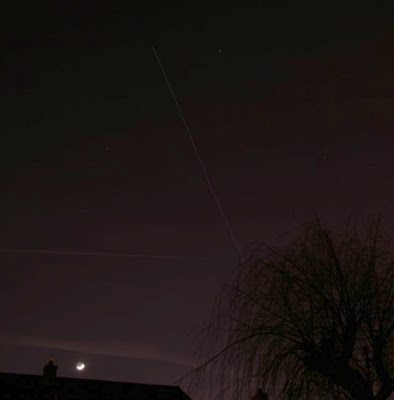
And here it is setting, going past Mars. Two images overlayed.

You can see it rising above a tree in this trail, although there is also a confusing contrail moving horizontally.

And here it is setting, going past Mars. Two images overlayed.

Friday, 8 February 2008
How things stack up
I had attempted to stack a number of the orion images together - but ran into some lack of knowledge with my attempts to drive DeepSkyStacker. It was doing unspeakable things to my images and they looked far worse than when I started out the process.
After some discussions with the author I learnt a little more about using the program, and after some trial and error got something that was better than what I started out with.
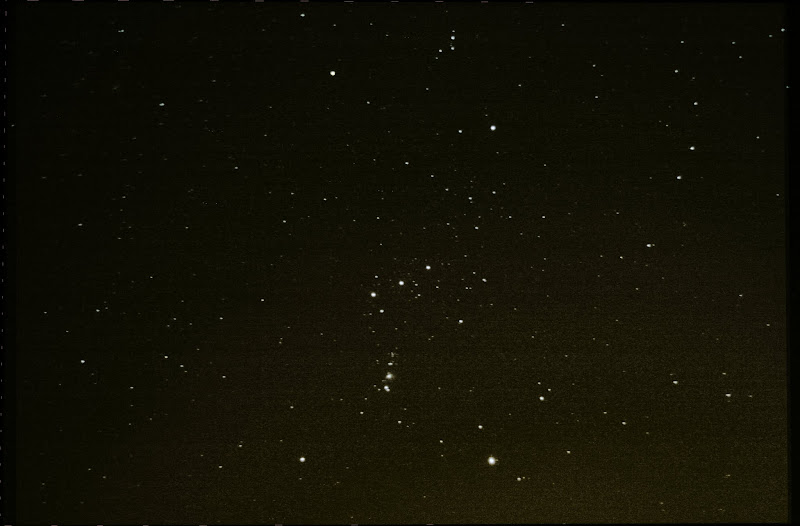
Hurrah!
After some discussions with the author I learnt a little more about using the program, and after some trial and error got something that was better than what I started out with.

Hurrah!
Thursday, 7 February 2008
Wide sky pictures
I've been looking around for a while for a way to attach the camera on top of the telescope, and so allow photographs to be taken through the camera lens. This allows some wider field photography, where you can capture constellations and stuff. There were a couple of places that sell these sort of attachment for my telescope in the U.S., and some places in the UK but all out of stock. Also they seem reasonably expensive at about £80 or so.
So - when in a DIY shop yesterday, I spotted some velcro attachment straps. These are long enough to wrap about the main body of the telescope, and strap a small bendy tabletop tripod that came free with the camera onto the main tube. It looks like this:

So - I tried a little constellation photography.

This shows the effect of light pollution quite well! After a little cleaning up

I doubt it will win awards, but its a start!
So - when in a DIY shop yesterday, I spotted some velcro attachment straps. These are long enough to wrap about the main body of the telescope, and strap a small bendy tabletop tripod that came free with the camera onto the main tube. It looks like this:
So - I tried a little constellation photography.

This shows the effect of light pollution quite well! After a little cleaning up

I doubt it will win awards, but its a start!
Wednesday, 6 February 2008
Getting more familiar
Tonight I thought I should push my comfort zone. I'd spent a happy afternoon a while ago playing with the remote controls on the autostar controller via a serial link to a laptop. It allows you to control all aspects remotely.
I'd also read a bit about polar aligning the telescope - this looked a little scary, not least because of the rather crazy angle everything ends up at. After having read through it a couple of times though, it didn't seem to be so scary, and practising a couple of times indoors in the light helps!
Anyway - after a few false starts outside - like finding the "home" position for polar alignment, it all came together. It was really quite easy. It looks a bit weird, but it works. I tried imaging Saturn as a test, and tried using the tracking option to keep the telescope centred on the planet. I'm not sure if it worked or not, it did seem to drift out of view, but it could be down to operator error.
The pictures of Saturn weren't any better than any I've taken before so I won't bother showing them.
I'd also read a bit about polar aligning the telescope - this looked a little scary, not least because of the rather crazy angle everything ends up at. After having read through it a couple of times though, it didn't seem to be so scary, and practising a couple of times indoors in the light helps!
Anyway - after a few false starts outside - like finding the "home" position for polar alignment, it all came together. It was really quite easy. It looks a bit weird, but it works. I tried imaging Saturn as a test, and tried using the tracking option to keep the telescope centred on the planet. I'm not sure if it worked or not, it did seem to drift out of view, but it could be down to operator error.
The pictures of Saturn weren't any better than any I've taken before so I won't bother showing them.
Tuesday, 5 February 2008
Deep Sky
I had tried out some deep sky images with my new camera, but was rather disappointed in the results. I know I shouldn't expect great results on the first try, but all the images showed some degree of movement of the stars. Either this was camera shake because of the action of the mirror moving, and me pressing the button (but I tried using the "hat" trick to avoid that and they were still there). Otherwise it could be the motors on the scope not tracking as accurately as I hoped.
Last night I decided to experiment, and tried the LPI, which was not designed for deep sky objects, on M42 in Orion. I was reasonably impressed with the results. With an exposure setting of just over a second, the results were quite good.

After a bit of post processing, the stars are obvious and there is even a bit of nebula glow.
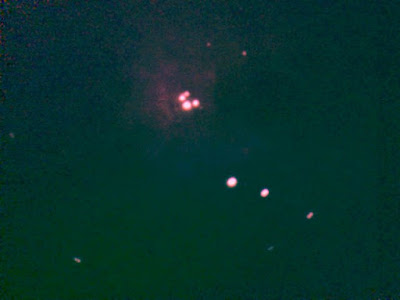

Better than with the camera anyway.
Last night I decided to experiment, and tried the LPI, which was not designed for deep sky objects, on M42 in Orion. I was reasonably impressed with the results. With an exposure setting of just over a second, the results were quite good.

After a bit of post processing, the stars are obvious and there is even a bit of nebula glow.


Better than with the camera anyway.
Friday, 1 February 2008
A new camera - and a clear night
My new camera arrived - a Canon EOS 400D. The good news about this is that it will do long exposures. It will do timed exposures up to 30s, and has a bulb setting for arbitrary times.
The bad news is it is quite a complex bit of kit, and will take some time to get to know how to use it.
The good news - its a clear night. The bad news - I'm not even sure how to switch on the camera, let alone use it.
Still - a clear night is not to be wasted, so I set up the equipment, and managed to get the camera attached to the back of the telescope with the appropriate adapters. Focusing was as difficult with this as with the LPI interface I soon found out. I also managed to confuse myself a number of times with the mirror setting. This allows you to either view from the top or straight through, but typically I'd find the right star with the normal eyepiece, then try and focus the camera and find it pitch black. Then it would tumble - I had to switch the mirrors over!
I tried some images of M42 and got some results, which is more than I'd ever done before. They weren't very good though. The wind was howling around and a number of roads had been closed to high sided vehicles, so it wasn't a good setting for long exposures. I also found that the mirror movement caused blurring and although I think there is a setting to disable that, I didn't know what it was. I reverted to the hat-trick - where you cover the lens, press the shutter, wait for a second for it to steady, then uncover the lens. I also covered it up towards the end of the shot for good measure. The wind continued to come in gusts though.
However with a bit of fiddling around on one of the better shots I go something that looked nebula-ish.

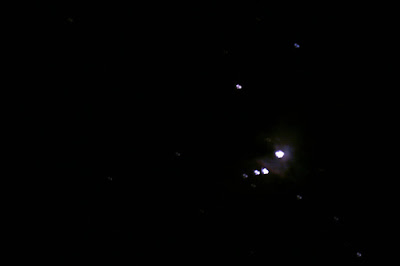
I tried Saturn too, but just guessed at the exposure, and it came out over exposed. I was getting very cold fingers by this time!

I then took some more images of Saturn with the LPI experimenting with the FITs save format, but couldn't get registax to accept them in any reasonable way.
The bad news is it is quite a complex bit of kit, and will take some time to get to know how to use it.
The good news - its a clear night. The bad news - I'm not even sure how to switch on the camera, let alone use it.
Still - a clear night is not to be wasted, so I set up the equipment, and managed to get the camera attached to the back of the telescope with the appropriate adapters. Focusing was as difficult with this as with the LPI interface I soon found out. I also managed to confuse myself a number of times with the mirror setting. This allows you to either view from the top or straight through, but typically I'd find the right star with the normal eyepiece, then try and focus the camera and find it pitch black. Then it would tumble - I had to switch the mirrors over!
I tried some images of M42 and got some results, which is more than I'd ever done before. They weren't very good though. The wind was howling around and a number of roads had been closed to high sided vehicles, so it wasn't a good setting for long exposures. I also found that the mirror movement caused blurring and although I think there is a setting to disable that, I didn't know what it was. I reverted to the hat-trick - where you cover the lens, press the shutter, wait for a second for it to steady, then uncover the lens. I also covered it up towards the end of the shot for good measure. The wind continued to come in gusts though.
However with a bit of fiddling around on one of the better shots I go something that looked nebula-ish.


I tried Saturn too, but just guessed at the exposure, and it came out over exposed. I was getting very cold fingers by this time!

I then took some more images of Saturn with the LPI experimenting with the FITs save format, but couldn't get registax to accept them in any reasonable way.
Thursday, 31 January 2008
Clouds and more clouds
The last few days there has been nothing worth looking at during the night. Plenty of overcast, rain, wind etc.
So I've spent the time spending money instead. I've got a camera adapter together with a mounting ring for a Canon camera so I can turn the whole telescope into a huge camera lens. I'm still waiting for my camera to arrive, but the adapters are here. The adapter has another use in that you can also use it to mount lenses in, so as well as looking down with one lens, you can look straight through with another. This will be helpful for keeping the target in the right place. There is a mirror that flips up and down to divert the light to the normal viewing position or straight through.
Meanwhile, I'm looking into getting a better pair of binoculars - ones with a larger objective lens for better night viewing.
So not much progress basically.
So I've spent the time spending money instead. I've got a camera adapter together with a mounting ring for a Canon camera so I can turn the whole telescope into a huge camera lens. I'm still waiting for my camera to arrive, but the adapters are here. The adapter has another use in that you can also use it to mount lenses in, so as well as looking down with one lens, you can look straight through with another. This will be helpful for keeping the target in the right place. There is a mirror that flips up and down to divert the light to the normal viewing position or straight through.
Meanwhile, I'm looking into getting a better pair of binoculars - ones with a larger objective lens for better night viewing.
So not much progress basically.
Friday, 25 January 2008
A clear night at last
As I sat in the office during the day, I kept sneaking a look out of the window, and there was a fair degree of blue sky visible. There were a few clouds around, but not the solid overcast that has been so common the last few weeks. I didn't dare to hope...
On the drive home, I tried squinting at the sky, to see if I could see stars. Its not very easy though, as you are speeding along to try and glimpse them amongst the street lights and tail lights.
When I jumped out of the car though, it was clear that there were stars visible, and I rushed inside, and took the telescope outside immediately to start cooling down. There seems to be quite a lot of equipment to get carried out to get set up properly. Telescope, battery power tank, hand controller, selection of lenses, table, laptop, power cable for laptop, CCD camera, digital camera, star chart...
Anyway - in between grabbing some bites for tea, and not helping get the children into bed, and loosing the mains adapter, I managed to get all set up. I aligned the telescope, and then jumped to Mars as a first test. I wanted to try out some new ideas with the LPI camera and see what I could do. Unfortunately, Mars is now almost overhead, and the telescope doesn't like such objects quite as much. First its a little harder to see in that position - and the flexible focusing adapter is bent into a 90° angle. Another problem is with the Alt-Az mounting you are close to the issue of gimble lock. When looking upwards, which way is up/down and which way right/left. I'm confused, and so are the telescope motors. I know I want it to go THIS way, but its not so clear which way that is.
Anyway - I did get it on target, but I was rather disappointed with the results.
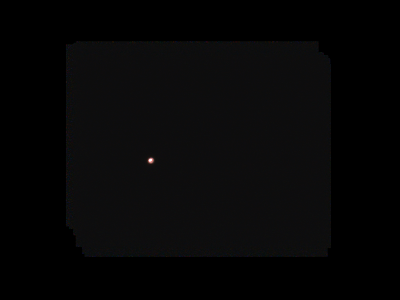
I think it is still overexposed, and clearly more work is needed.
So I waited for a while for the moon to rise. It is full at the moment, so very bright. It rose behind my increasingly least favourite tree in the neighbours garden! So I had a go at imaging that, and the results were better.

This was taken through the branches of the tree, so was subject to a bit of interference. It was about 80 images stacked together. The software has an option to save all the frames for later processing, so I took some more pictures to try processing later.
The moon was now out from behind the tree, and Saturn was very closely following it. I had a go at imaging Saturn through the tree, and managed to get some reasonable shots this time. As Saturn is very close to the moon, it is almost lost in the glow from it.

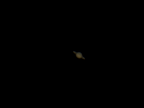
I saved the raw images again to process later. Finally, still not clear whether the LPI camera was giving better results, I took a high magnification lens, and connected the digital camera afocally to it, and took a movie of Saturn. By now I'd been outside in the cold for several hours and was running out of ideas, enthusiasm and warmth, so I wasn't as careful as I could be - it all gets a bit fiddly in the dark and concentration is hard to maintain. After processing in registax, it did look like a recognisable Saturn.

Its at a bit of an unusal angle as I had all sorts of issues getting the camera adapter aligned and connected without thumb screws running into each other.
So I took the telescope inside, and packed up. I then went and had a go at reprocessing the raw images, and the registax program is very good. It can be a bit tricky to work with, but the results were more impressive.
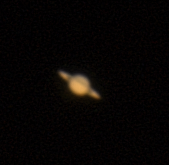


I was pleased to see some reasonable colours coming through too - perhaps I'd got the exposure better.
Finally, a quick processing of the saved moon images too for comparison.
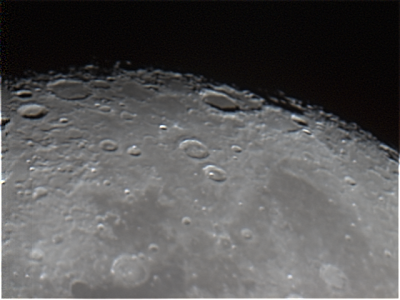
Much better! A good evenings work, I wonder when the next one will come around! Looking out the bedroom window on the way to bed, I was pleased to see in a rather selfish way, that most of the sky was now obscured by cloud. My decision to pack away was vindicated.
On the drive home, I tried squinting at the sky, to see if I could see stars. Its not very easy though, as you are speeding along to try and glimpse them amongst the street lights and tail lights.
When I jumped out of the car though, it was clear that there were stars visible, and I rushed inside, and took the telescope outside immediately to start cooling down. There seems to be quite a lot of equipment to get carried out to get set up properly. Telescope, battery power tank, hand controller, selection of lenses, table, laptop, power cable for laptop, CCD camera, digital camera, star chart...
Anyway - in between grabbing some bites for tea, and not helping get the children into bed, and loosing the mains adapter, I managed to get all set up. I aligned the telescope, and then jumped to Mars as a first test. I wanted to try out some new ideas with the LPI camera and see what I could do. Unfortunately, Mars is now almost overhead, and the telescope doesn't like such objects quite as much. First its a little harder to see in that position - and the flexible focusing adapter is bent into a 90° angle. Another problem is with the Alt-Az mounting you are close to the issue of gimble lock. When looking upwards, which way is up/down and which way right/left. I'm confused, and so are the telescope motors. I know I want it to go THIS way, but its not so clear which way that is.
Anyway - I did get it on target, but I was rather disappointed with the results.

I think it is still overexposed, and clearly more work is needed.
So I waited for a while for the moon to rise. It is full at the moment, so very bright. It rose behind my increasingly least favourite tree in the neighbours garden! So I had a go at imaging that, and the results were better.

This was taken through the branches of the tree, so was subject to a bit of interference. It was about 80 images stacked together. The software has an option to save all the frames for later processing, so I took some more pictures to try processing later.
The moon was now out from behind the tree, and Saturn was very closely following it. I had a go at imaging Saturn through the tree, and managed to get some reasonable shots this time. As Saturn is very close to the moon, it is almost lost in the glow from it.


I saved the raw images again to process later. Finally, still not clear whether the LPI camera was giving better results, I took a high magnification lens, and connected the digital camera afocally to it, and took a movie of Saturn. By now I'd been outside in the cold for several hours and was running out of ideas, enthusiasm and warmth, so I wasn't as careful as I could be - it all gets a bit fiddly in the dark and concentration is hard to maintain. After processing in registax, it did look like a recognisable Saturn.

Its at a bit of an unusal angle as I had all sorts of issues getting the camera adapter aligned and connected without thumb screws running into each other.
So I took the telescope inside, and packed up. I then went and had a go at reprocessing the raw images, and the registax program is very good. It can be a bit tricky to work with, but the results were more impressive.



I was pleased to see some reasonable colours coming through too - perhaps I'd got the exposure better.
Finally, a quick processing of the saved moon images too for comparison.

Much better! A good evenings work, I wonder when the next one will come around! Looking out the bedroom window on the way to bed, I was pleased to see in a rather selfish way, that most of the sky was now obscured by cloud. My decision to pack away was vindicated.
Wednesday, 23 January 2008
A possible breakthrough
I was looking back at my attempts to focus on a CD across the garden for practice. I was struck by how much more fuzzy the LPI image was than how it looked through the telescope. I also compared some images I'd taken with the digital camera held up to the eyepiece compared with the LPI camera. I'd also found images others had taken on the web with the LPI camera, and they all looked far better than my images. OK - some of them had much better telescopes than mine, but not all of them had.
So during yet another wet day, I took a careful look at the LPI camera. There isn't that much to it really. There is a dust cap to take off, and that's it. If you look down the tube, you can just about see a small electrical chip, but there is no lens or anything.
So anyway, I wondered how the digi camera would compare with the Meade LPI, if my hunch that the digital camera was outperforming the LPI direct by some stretch.
So - another set up, focusing on the same CD. I took a short digi film through a reasonably high powered eyepiece. Then I got out the LPI again. I had another quick look at it, and wondered if there was a possibility there might be some dust or something on the CCD. Just in case I pushed one end of the lens cleaning cloth gently down the tube and gave a gentle twist just in case.
Then I fired up the laptop and got the software running. A few tweaks on the new flexible focusing knob, and I was astonished. The image was vastly better than before. There was so much detail evident I could hardly believe it. I mean - just compare the before and after:
I mean - tell that isn't at least 100% better!
I didn't even bother taking the movie off the camera for comparison. Of course now I'm itching to try this out on something celestial, but the weather is not cooperating. There was a brief patch of clear sky monday night, and I rushed to get the telescope out and set up. Even as I was carrying out though the 4 or 5 stars I could see were fading. By the time I had it ready, there was a slow drizzle which gradually got worse until it was full rain.
Sigh, this waiting lark is tough!
So during yet another wet day, I took a careful look at the LPI camera. There isn't that much to it really. There is a dust cap to take off, and that's it. If you look down the tube, you can just about see a small electrical chip, but there is no lens or anything.
So anyway, I wondered how the digi camera would compare with the Meade LPI, if my hunch that the digital camera was outperforming the LPI direct by some stretch.
So - another set up, focusing on the same CD. I took a short digi film through a reasonably high powered eyepiece. Then I got out the LPI again. I had another quick look at it, and wondered if there was a possibility there might be some dust or something on the CCD. Just in case I pushed one end of the lens cleaning cloth gently down the tube and gave a gentle twist just in case.
Then I fired up the laptop and got the software running. A few tweaks on the new flexible focusing knob, and I was astonished. The image was vastly better than before. There was so much detail evident I could hardly believe it. I mean - just compare the before and after:
I mean - tell that isn't at least 100% better!
I didn't even bother taking the movie off the camera for comparison. Of course now I'm itching to try this out on something celestial, but the weather is not cooperating. There was a brief patch of clear sky monday night, and I rushed to get the telescope out and set up. Even as I was carrying out though the 4 or 5 stars I could see were fading. By the time I had it ready, there was a slow drizzle which gradually got worse until it was full rain.
Sigh, this waiting lark is tough!
Subscribe to:
Posts (Atom)




